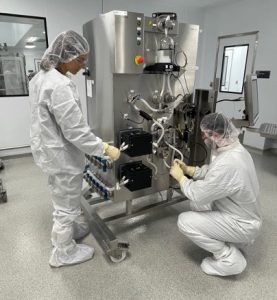
Two and a half years after expanding its primary focus areas to include gene therapy, Astellas Gene Therapies has raised its investment in the specialty—and it hopes, positioned itself for future success—by opening a $100 million manufacturing facility in Sanford, NC.
Astellas’ new late-stage clinical and commercial manufacturing facility is the company’s third facility devoted to producing gene therapies, joining sites in Tsukuba, Japan, 45 miles northeast of the pharma giant’s headquarters in Tokyo, and South San Francisco, CA.
While the Tsukuba facility focuses on supporting early research and early process development work, identifying how to best make gene therapies at early stages of research, the South San Francisco site is a good manufacturing practice (GMP) facility, and until now the only one of Astellas’ sites capable of clinical- to commercial-scale production of gene therapies.
But as Astellas has expanded its gene therapy pipeline to 14 programs, the company concluded that it needed greater capacity to manufacture its candidates for clinical trials and, eventually, at commercial scale.
“With just the San Francisco site, we can only produce material in series. Every program had to wait in line to get a slot,” Mathew Pletcher, PhD, Senior Vice President and Division Head of Gene Therapy Research and Technical Operations at Astellas Gene Therapies, told GEN Edge.
The new 135,000-square-foot gene therapy facility, at 6074 Enterprise Park Drive within Central Carolina Enterprise Park, opened with an initial capacity of 4,000 liters of production. The site is designed for future expansion within its walls to accommodate an additional 16,000 liters of capacity—a potential for expansion Astellas lacks in South San Francisco, a site that also has a capacity of 4,000 liters.
“We’re moving some of our clinical supply production from San Francisco out to the Sanford site. The first work it takes on is supporting our current clinical programs,” Pletcher said.
In Sanford, he said, Astellas can build out even more capacity if needed in the future beyond what its walls can accommodate: “I’d say we have substantial space to add additional buildings as necessary.”
“Now that we have the capacity of Sanford online, it really allows us to do multiple programs in parallel, so we can really get to the point that manufacturing will never be the limiting factor in our programs moving forward, our programs meeting their timelines,” Pletcher explained.
Astellas will still need FDA approval to begin commercial production.
Pletcher added that the Sanford site also benefits Astellas by giving it greater flexibility in gene therapy manufacturing.
“That facility [South San Francisco] has been the one that has been supporting all the clinical trials, up till now. So the other benefit here is this does provide us redundancy as well,” Pletcher said. “Now we have two sites that are able to do this, so if something were to happen at one it doesn’t take our programs completely offline. Now, we have the ability to adjust to any short-term issues at one side or the other, and still continue to supply material to the patients.”
Work in Progress
Gene therapy development is still something of a work in progress for Astellas, whose top-selling drug is the cancer treatment Xtandi® (enzalutamide) co-marketed with Pfizer. Xtandi generated ¥534.3 billion (nearly $4 billion) for Astellas in the “2021” fiscal year that ended March 31, up 16.6% from a year earlier. Astellas’ next best-selling drug is Prograf® (tacrolimus), a treatment to prevent organ rejection in kidney, liver, heart, or lung transplant patients; Prograf racked up ¥185.4 billion ($1.388 billion) for the company in FY 2021.
Last year, Astellas launched a five-year Corporate Strategic Plan covering the 2001-2026 fiscal years
Of Astellas’ 14 gene therapy candidates in its pipeline, only two have reached clinical phases. One is resamirigene bilparvovec (previously known as AT132), a gene replacement therapy for X-linked Myotubular Myopathy (XLMTM) consists of an AAV8 vector containing a functional copy of the MTM1 gene, to transfect and express myotubularin in skeletal muscle cells.
The other is AT845, a gene replacement therapy for Pompe disease caused by mutations in the gene encoding the lysosomal enzyme alpha-glucosidase (GAA).
Both candidates came to Astellas through its $3 billion acquisition of Audentes Therapeutics, completed in January 2020. At the time, resamirigene bilparvovec was the lead pipeline program of Audentes, which Astellas repositioned as its Astellas Gene Therapies Center of Excellence.
Astellas’ development of resamirigene bilparvovec has been hindered by four patient deaths in the Phase I/II ASPIRO trial (NCT03199469), which led the FDA to impose two clinical holds. The first was imposed in 2020 after the company acknowledged the deaths of three boys who received the higher of two doses (3.5×1014 vg/kg) before they started to demonstrate signs of liver dysfunction within 3 to 4 weeks after dosing.
The second clinical hold was imposed in September 2021, after Astellas acknowledged the death of a fourth boy in the ASPIRO trial. Unlike the other three boys who died, the fourth was dosed at the trial’s lower dose of 1.3×1014 vg/kg. That second hold remains in effect.
“We plan to go back to regulators for discussions come the fall,” Pletcher said.
Lower sales forecast
In releasing FY 2021 results in April, Astellas lowered its potential peak sales forecast for resamirigene bilparvovec to under ¥50 billion (approximately $374 million), from the previous peak sales range of between ¥50 million and ¥100 million (about $748 million). The gene therapy candidate is still listed among Astellas’ key “strategic products” whose development the company plans to prioritize.
Astellas also booked an impairment loss “on intangible assets and goodwill” of ¥31.2 billion ($233 million) for the review of its development plan for resamirigene bilparvovec that followed the second clinical hold.
By contrast, AT845 has generated better results to date for Astellas.
In February at the 18th Annual WORLDSymposium in San Diego, the company presented positive interim safety data for AT845 from the Phase I/II FORTIS trial (NCT04174105) showing no serious adverse events reported following dosing in any of the four participants as of the time of the data cut. As of the December 3, 2021 data cut-off date, four participants were enrolled in FORTIS, with two participants dosed at 3 x 1013 vg/kg (Cohort 1) and two participants dosed at 6 x 1013 vg/kg (Cohort 2).
Another challenge Astellas has faced in gene therapy development has been disappointing preclinical results for three preclinical gene therapy candidates designed to treat Duchenne Muscular Dystrophy (DMD).
In April, Astellas scrapped development of AT702 and two earlier phase DMD candidates, AT751 and AT753, “based on recent preclinical study data.” The company said it would book an impairment charge of $170 million for loss of intangible assets among other expenses when the company reports results for the first quarter of its 2022 fiscal year (April, May, and June).
The three gene therapies were designed to treat separate groups of patients by targeting different DMD gene exons. AT702 was an AAV-antisense candidate designed to induce exon 2 skipping for DMD with duplications of exon 2 and mutations in exons 1-5 of the dystrophin gene.
AT702 was originally developed by researchers at the NCH, which licensed the gene therapy to Audentes Therapeutics in 2019. After showing a dose-dependent increase in dystrophin levels and improvements in muscle function in a mouse model with a DMD exon 2 duplication, Audentes and the National Children’s Hospital (NCH) launched a Phase I/II trial of AT702 (NCT04240314).
AT751 and AT753 were also vectorized exon skipping candidates designed to treat DMD patients with genotypes amenable to exon 51 and exon 53 skipping, respectively.
Astellas has disclosed some of its preclinical gene therapy candidates, including three that are in discovery phases:
- AT466, a vectorized, exon skipping / vectorized RNA knockdown for the DMPK gene, targeting myotonic dystrophy.
- AT808, a gene replacement therapy for Friedreich’s Ataxia.
- A program to treat Angelman Syndrome by restoring the UBE3A gene
Other gene therapy candidates disclosed by Astellas:
- ASP1015, a glaucoma gene therapy inherited when it acquired Quethera in 2018, for which an IND is planned for 2023;
- Programs to develop a gene therapy for dry age-related macular degeneration (dry AMD) and other macular degeneration indications, being developed in collaboration with University of Pittsburgh;
- Two preclinical muscle disease candidates that Astellas is developing with Modalis Therapeutics, MDL-201 and MDL-202. The mechanisms for both have not been disclosed.
“Our current area focus is on Mendelian rare diseases, but we have a long-term goal of moving into more common diseases. And if we’re going to do that, obviously we’re going to need a much greater capacity, and that’s what [the Sanford facility] allows us to do,” Pletcher said.
200 jobs planned

Astellas expects to create more than 200 jobs through 2026 in Sanford, NC.
“We have roughly around 50 people there now, and it’ll continue to grow as the portfolio dictates,” Pletcher said.
He said Astellas’ hiring in Sanford “really speaks to every aspect of the manufacturing process,” from highly technical positions, to managers and strategic leaders, to support staffers: “It really is all aspects of what it takes to make a gene therapy.”
Should the company meet its job creation forecast, Astellas stands to gain more than $9 million in economic incentives that include a state Job Development Investment Grant worth up to $3.7 million, and up to $5.7 million from the City of Sanford and surrounding Lee County. Astellas also could receive nearly $400,000 in training support from the North Carolina Community College System.
The economic incentives and the presence of numerous colleges helped sway Audentes to choose Sanford, NC, over sites in Massachusetts, California, and Colorado for its third gene therapy manufacturing facility. Pletcher cited the cluster within a cluster of gene therapy activity—and resulting workforce—that have emerged in recent years in Sanford, Lee County, and two areas located some 40 miles north, Raleigh and Research Triangle Park (RTP).
In Sanford, Pfizer over the past two years has carried out a $500 million facility expansion in Sanford that was designed to expand its manufacturing of gene therapies, and add 300 jobs to a workforce that stood at 650 when the expansion was announced in 2019.
Pletcher cited the presence within RTP of Asklepios BioPharmaceutical (AskBio), the gene therapy developer whose platform is based on the work of R. Jude Samulski, PhD, who founded AskBio in 2001. Samulski was first to show that AAV could be cloned for therapeutic purposes and used as a vector in delivering gene therapy. Bayer acquired AskBio for up to $4 billion in a deal completed in December 2020.
“North Carolina has been a hotbed of gene therapy, from the beginning as innovators like Jude Samulski came out of the academic centers. There’s a lot of people in the area who know this space and space well, so it allows us to really draw on local talent and to build out,” Pletcher said.
“But the other key part of this is the fact that we built a facility on space that allows us to continue to expand as needed,” he continued. “And then, if we grow even beyond the building that’s there, we have the space to continue to add on, which is obviously not the case in South San Francisco.”





